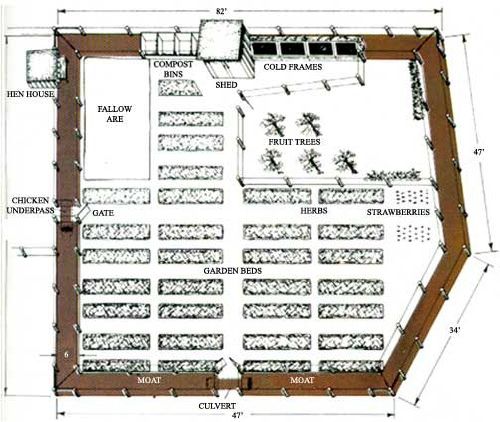A chicken moat is not a waterway, but it does provide a protective enclosure for the garden. Weeds, insects, rabbits, groundhogs and even deer are barred from entry by the double wall of fencing and the ever-diligent patrol flock. All in all, it’s a clever solution to the fowl raiser’s dilemma of whether to fence the birds or the garden: Fence both!
In days gone by, rulers of kingdoms would protect themselves by ordering a few thousand serfs to build a moat around the family castle. With the current shortage of serfs, the practice has fallen out of favor. However, when faced with that classic country conundrum, “Do I fence the garden or the chickens?” I decided to make a modern adaptation of that medieval practice. I fenced both fowl and crops—with a chicken moat.
My moat is simply a strip of dry land, enclosed by two parallel fences, which surrounds my family’s garden. Throughout the day, the hen patrol moves all around the garden (but never in it), munching on all those things hens love: weeds, seeds, worms, tiny pieces of stones and (best of all) bugs.

The chicken moat provides a clean edge around the garden, keeping down the migration of unwanted grasses, weeds, and insects into our plot. (Two years ago, when our neighbor’s garden was nearly devastated by grasshoppers, our hens gorged themselves on the invading horde and saved our plot.) The double line of defense discourages most possums, groundhogs, and rabbits from trying to harvest free vegetables. Deer can easily clear a single tall fence, but they can’t find enough room in the six-foot-wide moat to gather themselves for a second leap. And we’ve quit losing hens to hawks since the moat was constructed—those raptors avoid the potential entrapment of two fences so close together.
If you wish to construct a moat yourself, I offer the following suggestions:
- Do a thorough site inspection and plenty of pencil-and-paper planning first.
- Buy six-foot fencing (in quantity to save money) of a heavier, more durable gauge than regular chicken wire. It’s going to take a good bit of work to build your moat: Construct it of durable materials so you won’t have to do the job again later.
- Build your gates strong and tight—they’re the weak links in the system. And be sure to make at least one gate wider than the widest object (garden cart, tiller, whatever) you will ever wish to move in or out of the garden.
- Build a tunnel under every gateway out of culvert or concrete block so the hens can easily move between all sections of the moat.
- Erect your outer fence first, bracing it securely with diagonal posts at all corners and ends. You can then wire your inner fence to your outer one, as shown in the detail drawing. You’d also be wise to dig a trench and partly bury the outer fence (holding it down with cedar stakes) to discourage burrowing varmints.
- Make sure you can get into the moat (with a stepladder or extra gate) for needed maintenance. We “roofed” the section of the moat near Taj Mahen (our chicken coop) with standard poultry mesh. This area can be closed off, giving the flock a safe haven when we are away overnight. We also designed our moat and hen house complex to provide about 80 square feet per hen. A greater ratio of hens to the area would be better; as the season progresses, the weeds grow faster than the flock can eat them.
- And one last tip (the old free breakfast trick): Leave some old boards in the moat, and flip them over with a hoe handle each morning to expose hiding slugs.
So there it is. Want to be king or queen of all (the garden) you survey? Build a chicken moat!













2 Comments
How many chickens do you have in this setup?
This is a really awesome set up. I wish I could see the photo better though. Could you email it to me please?